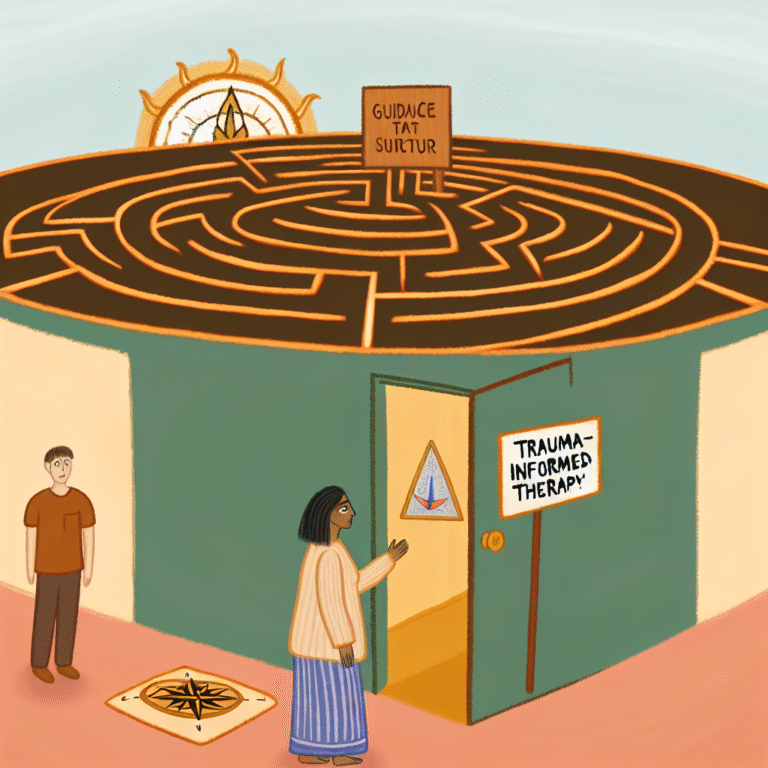
Prioritizing Your Well-Being: A Guide to Identifying Trauma-Informed Therapists
Introduction
In a world that often prioritizes hustle over health, the necessity of prioritizing your well-being has never been more prominent. Understanding mental health, especially when it comes to overcoming past traumas, has become an increasingly critical part of our collective journey toward wellness. However, finding the right therapist can feel like navigating a maze. Not only do you want someone knowledgeable, but it’s essential they understand the complexities of trauma-informed care. This guide aims to demystify the process of finding the right trauma-informed therapist, offering valuable insights on why it matters and how to identify the best fit for your journey.
Understanding Trauma and Its Impact on Well-Being
Trauma affects us in many forms, from emotional and psychological distress to impacting physical health and relationships. When prioritizing your well-being, it’s crucial to understand how trauma resonates within you.
The Ripple Effect of Trauma
Let’s consider a case study: Sarah, a 27-year-old woman, experienced childhood neglect that manifested in anxiety and difficulties in relationships as she grew older. This scenario illustrates a common reality—trauma is not merely a thing of the past but can set off a series of emotional and psychological reactions long after the event has occurred.
Table 1: Types of Trauma
| Type of Trauma | Description |
|---|---|
| Acute Trauma | A single incident that causes significant distress |
| Chronic Trauma | Repeated exposure to traumatic events over time |
| Complex Trauma | Experiencing multiple traumas, often in childhood |
| Collective Trauma | Trauma experienced by a group (e.g., communities, cultures) |
The Importance of Trauma-Informed Therapy
Prioritizing your well-being is inherently tied to seeking out care that understands your individual experiences. Trauma-informed therapy is not just about treating symptoms, but about recognizing and responding to the ways trauma can affect a person’s life.
Key Principles of Trauma-Informed Care
- Safety: Establishing a therapeutic environment where clients feel physically and emotionally safe.
- Trustworthiness: Ensuring transparency in the therapeutic process.
- Peer Support: Valuing the role of personal experiences and shared understanding.
- Collaboration and Empowerment: Encouraging clients to take an active role in their healing.
- Cultural, Historical, and Gender Issues: Being sensitive to the diverse backgrounds and identities of clients.
Identifying Trauma-Informed Therapists
Where to Start Your Search
When searching for a therapist, consider these methods:
- Referrals: Ask trusted friends, family, or doctors for recommendations.
- Online Directories: Use platforms like Psychology Today or TherapyDen to find therapists explicit in trauma-informed care.
- Professional Associations: Organizations such as the Trauma Informed Care Project can offer directories of trained therapists.
Signs of a Trauma-Informed Therapist
During your search, look for therapists who:
- Demonstrate Empathy: A trauma-informed therapist listens without judgment, providing an emotionally safe space.
- Utilize Evidence-Based Practices: They should apply therapy methods proven effective in trauma treatment, like CBT, EMDR, or DBT.
- Encourage Client Autonomy: They respect your viewpoint and decisions, fostering a collaborative therapeutic environment.
Questions to Ask Potential Therapists
To effectively screen potential therapists, consider asking:
- What is your experience with trauma-informed care?
- How do you incorporate trauma awareness into your therapy sessions?
- What methods do you use to create a safe therapeutic space?
Case Study Analysis
Let’s revisit Sarah. After connecting with a trauma-informed therapist who utilized EMDR, she began to understand the impacts of her childhood trauma. Her therapist emphasized creating a safe environment for Sarah to explore her experiences, ultimately boosting her emotional resilience and improving her relationships—a testament to the effectiveness of trauma-informed care.
Strategies for Prioritizing Your Well-Being During Therapy
Develop a Relationship of Trust
Establishing trust is fundamental in therapy. Don’t hesitate to voice discomfort with certain methods—an open dialogue can enhance your experience.
Set Goals for Your Therapy
Define your objectives to stay focused and gauge progress. Whether it’s managing anxiety triggers or building self-esteem, goal-setting is vital.
Self-Care Practices
In conjunction with therapy, engage in self-care practices that foster your mental and physical health. Here are a few effective strategies:
- Mindfulness and Meditation: Technical tools to ground yourself and enhance self-awareness.
- Physical Activity: Exercise releases endorphins and helps alleviate stress.
- Journaling: Reflecting on your progress and emotions can provide clarity and insight.
The Role of Community and Support Systems
Prioritizing your well-being extends beyond therapy; it encompasses a supportive community. Engaging in peer support groups can reinforce your journey, offering shared experiences that empower healing.
Peer Support Resources
- Support Groups: Look for local or online support groups that focus on trauma recovery.
- Mental Health Apps: Tools like Headspace or Calm can provide resources and community engagement focused on mindfulness and self-care.
Table 2: Benefits of Peer Support Groups
| Benefit | Description |
|---|---|
| Shared Experiences | Understanding that you’re not alone in your struggle |
| Emotional Validation | Gaining affirmation of feelings and experiences |
| Encouragement and Motivation | Boosts confidence through shared recovery journeys |
Conclusion
Prioritizing your well-being is not merely a recommendation—it’s a necessity for a fulfilling life. Identifying a trauma-informed therapist can provide the support you need on this transformative journey. By understanding the principles of trauma-informed care, utilizing resources effectively, and fostering a supportive community around you, you can cultivate an environment conducive to healing and growth. Remember, your past does not define your future; it is merely one chapter in your story.
Call to Action
As you embark on your journey toward healing, take a moment to reflect on your needs and experiences. Empower yourself by seeking out the resources, support, and care that resonate with your unique path. Your well-being is worth prioritizing.
FAQs
1. What is trauma-informed therapy?
Trauma-informed therapy recognizes the prevalence and impact of trauma in a person’s life and seeks to create a safe and supportive therapeutic environment.
2. How can I identify a trauma-informed therapist?
Look for therapists who emphasize safety, trustworthiness, and collaboration in their approach, and who have experience with trauma-related issues.
3. Is trauma-informed therapy effective for everyone?
While trauma-informed therapy can be beneficial for many, it’s essential to find a therapist and approach that resonates with your individual needs and preferences.
4. What should I do if I don’t connect with my therapist?
It’s important to feel comfortable and safe in therapy. If you don’t connect, don’t hesitate to seek a different therapist that better suits your needs.
5. How does community support enhance trauma recovery?
Community support offers shared understanding, validation, and encouragement, making the recovery journey less isolating and more empowering.
By focusing on prioritizing your well-being and identifying the right trauma-informed therapist, you can take significant steps toward a healthier, more fulfilling life.















